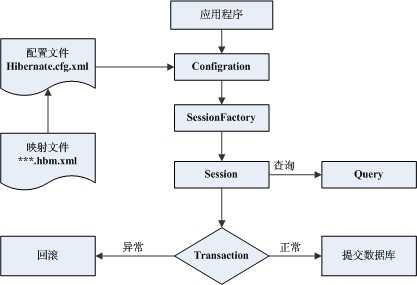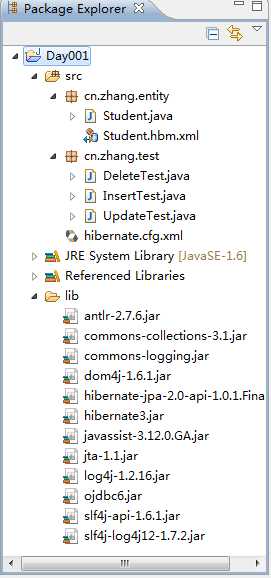标签:
Hibernate的核心组件
在基于MVC设计模式的JAVA WEB应用中,Hibernate可以作为模型层/数据访问层。它通过配置文件(hibernate.properties或hibernate.cfg.xml)和映射文件(***.hbm.xml)把JAVA对象或PO(Persistent Object,持久化对象)映射到数据库中的数据库,然后通过操作PO,对数据表中的数据进行增,删,改,查等操作。
除配置文件,映射文件和持久化类外,Hibernate的核心组件包括以下几部分:
a)Configuration类:用来读取Hibernate配置文件,并生成SessionFactory对象。
b)SessionFactory接口:产生Session实例工厂。
c)Session接口:用来操作PO。它有get(),load(),save(),update()和delete()等方法用来对PO进行加载,保存,更新及删除等操作。它是Hibernate的核心接口。
d)Query接口:用来对PO进行查询操。它可以从Session的createQuery()方法生成。
e)Transaction接口:用来管理Hibernate事务,它主要方法有commit()和rollback(),可以从Session的beginTrancation()方法生成。
Persistent Object
持久化对象可以是普通的Javabeans,惟一特殊的是它们与(仅一个)Session相关联。JavaBeans在Hibernate中存在三种状态:
1.临时状态(transient):当一个JavaBean对象在内存中孤立存在,不与数据库中的数据有任何关联关系时,那么这个JavaBeans对象就称为临时对象(Transient Object)。
2.持久化状态(persistent):当一个JavaBean对象与一个Session相关联时,就变成持久化对象(Persistent Object)
3.脱管状态(detached):在这个Session被关闭的同时,这个对象也会脱离持久化状态,就变成脱管状态(Detached Object),可以被应用程序的任何层自由使用,例如可以做与表示层打交道的数据舆对象(Data Transfer Object)。
Hibernate的运行过程
Hibernate的运行过程如下:
A:应用程序先调用Configration类,该类读取Hibernate的配置文件及映射文件中的信息,并用这些信息生成一个SessionFactpry对象。
B:然后从SessionFactory对象生成一个Session对象,并用Session对象生成Transaction对象;可通过Session对象的get(),load(),save(),update(),delete()和saveOrUpdate()等方法对PO进行加载,保存,更新,删除等操作;在查询的情况下,可通过Session对象生成一个Query对象,然后利用Query对象执行查询操作;如果没有异常,Transaction对象将 提交这些操作结果到数据库中。
Hibernate的运行过程如下图:

01.准备各种jar包(我想就不用我教了吧)
02.准备学生实体类(用于操作对应数据库)
package cn.zhang.entity;
//实体类
public class Student {
private int stuno;
private String stuname;
private int stuage;
private int stuid;
private int stuseat;
public Student() {
super();
// TODO Auto-generated constructor stub
}
public Student(String stuname, int stuage, int stuid, int stuseat) {
super();
this.stuname = stuname;
this.stuage = stuage;
this.stuid = stuid;
this.stuseat = stuseat;
}
public Student(int stuno, String stuname, int stuage, int stuid, int stuseat) {
super();
this.stuno = stuno;
this.stuname = stuname;
this.stuage = stuage;
this.stuid = stuid;
this.stuseat = stuseat;
}
public int getStuid() {
return stuid;
}
public void setStuid(int stuid) {
this.stuid = stuid;
}
public int getStuseat() {
return stuseat;
}
public void setStuseat(int stuseat) {
this.stuseat = stuseat;
}
public int getStuno() {
return stuno;
}
public void setStuno(int stuno) {
this.stuno = stuno;
}
public String getStuname() {
return stuname;
}
public void setStuname(String stuname) {
this.stuname = stuname;
}
public int getStuage() {
return stuage;
}
public void setStuage(int stuage) {
this.stuage = stuage;
}
}
03.在src下设计Hibernate配置文件hibernate.cfg.xml
<?xml version=‘1.0‘ encoding=‘utf-8‘?>
<!DOCTYPE hibernate-configuration PUBLIC
"-//Hibernate/Hibernate Configuration DTD 3.0//EN"
"http://www.hibernate.org/dtd/hibernate-configuration-3.0.dtd">
<hibernate-configuration>
<session-factory>
<!-- Database connection settings -->
<property name="connection.driver_class">oracle.jdbc.OracleDriver</property>
<property name="connection.url">jdbc:oracle:thin:@localhost:1521:orcl</property>
<property name="connection.username">zhangzong</property>
<property name="connection.password">123</property>
<!-- SQL dialect (SQL 方言)-->
<property name="dialect">org.hibernate.dialect.Oracle10gDialect</property>
<!-- Drop and re-create the database schema on startup -->
<property name="hbm2ddl.auto">update</property>
<!-- Echo all executed SQL to stdout 在控制台打印后台的SQL语句-->
<property name="show_sql">true</property>
<!-- 格式化显示SQL -->
<property name="format_sql">true</property>
<!-- JDBC connection pool (use the built-in) -->
<!-- <property name="connection.pool_size">1</property> -->
<!-- Enable Hibernate‘s automatic session context management -->
<!-- <property name="current_session_context_class">thread</property> -->
<!-- Disable the second-level cache -->
<!-- <property name="cache.provider_class">org.hibernate.cache.NoCacheProvider</property>-->
<mapping resource="cn/zhang/entity/Student.hbm.xml" />
</session-factory>
</hibernate-configuration>
04.在实体类下设计映射文件Student.hbm.xml(在配置文件hibernate.cfg.xml使用)
<?xml version="1.0"?>
<!DOCTYPE hibernate-mapping PUBLIC
"-//Hibernate/Hibernate Mapping DTD 3.0//EN"
"http://www.hibernate.org/dtd/hibernate-mapping-3.0.dtd">
<hibernate-mapping package="cn.zhang.entity">
<class name="Student" table="stuinfo">
<id name="stuno" column="stuno">
<!-- 主键生成策略:native:
native:如果后台是Oracle
后台是MySQL,自动应用自增 -->
<generator class="native"/>
</id>
<property name="stuname" type="string" column="stuname"/>
<property name="stuage"/>
<property name="stuid" type="int" column="stuid"/>
<property name="stuseat"/>
</class>
</hibernate-mapping>
05.添加测试类
001.更新(新增)一个学生记录
package cn.zhang.test;
//新增一条数据
import org.hibernate.SessionFactory;
import org.hibernate.Transaction;
import org.hibernate.cfg.Configuration;
import org.hibernate.classic.Session;
import cn.zhang.entity.Student;
public class InsertTest {
public static void main(String[] args) {
//准备对象
Student student=new Student("光衣", 12,112333,2);//Student.hbm.xml已配置编号为自增,所以这里不用添加编号了
//读取大配置文件,获取要连接的数据库信息
Configuration configuration=new Configuration().configure();
//创建SessionFactory
SessionFactory factory = configuration.buildSessionFactory();
//加工session
Session openSession = factory.openSession();
Transaction beginTransaction = openSession.beginTransaction();
openSession.save(student);
beginTransaction.commit();
System.out.println("成功");
}
}
002.修改一个学生信息
package cn.zhang.test;
import org.hibernate.SessionFactory;
import org.hibernate.Transaction;
import org.hibernate.cfg.Configuration;
import org.hibernate.classic.Session;
import cn.zhang.entity.Student;
public class UpdateTest {
/**
* @param args
*/
public static void main(String[] args) {
//1.读取大配置文件,获取要连接的数据库信息
Configuration conf=new Configuration().configure();
//2.创建SessionFactory
SessionFactory factory =conf.buildSessionFactory();
//3加工session
Session session = factory.openSession();
Transaction tx=session.beginTransaction();
//获取对象
Student stu =new Student(1,"光衣", 12,112333,2);
//更新
session.update(stu);
//提交事务
tx.commit();
System.out.println("更新成功");
}
}
003.删除一个指定学生信息
package cn.zhang.test;
import org.hibernate.SessionFactory;
import org.hibernate.Transaction;
import org.hibernate.cfg.Configuration;
import org.hibernate.classic.Session;
import cn.zhang.entity.Student;
public class DeleteTest {
public static void main(String[] args) {
//1.读取大配置文件,获取要连接的数据库信息
Configuration conf=new Configuration().configure();
//2.创建SessionFactory
SessionFactory factory =conf.buildSessionFactory();
//3.加工session
Session session = factory.openSession();
Transaction tx=session.beginTransaction();
//获取对象
Student stu =new Student();
stu.setStuno(3);//指定要删除的编号
//删除指定
session.delete(stu);
//提交事务
tx.commit();
System.out.println("删除成功");
}
}
004.查询一个指定学生信息
package cn.zhang.test;
import org.hibernate.SessionFactory;
import org.hibernate.cfg.Configuration;
import org.hibernate.classic.Session;
import cn.zhang.entity.Student;
public class SelectTest {
public static void main(String[] args) {
//1.读取大配置文件,获取要连接的数据库信息
Configuration conf=new Configuration().configure();
//2.创建SessionFactory
SessionFactory factory =conf.buildSessionFactory();
//3.打开session
Session session = factory.openSession();
//4.加载数据操作
//如果表中没有你指定的主键列,get()方法的是null
Student student =(Student)session.get(Student.class, 4);
//如果表中没有你指定的主键列,程序运行到student.getStuname()时会抛出异常
//Student student =(Student)session.load(Student.class, 4);
//5.输出数据
System.out.println(student.getStuname());
//6.关闭session
session.close();
}
}
标签:
原文地址:http://www.cnblogs.com/jingpeipei/p/5815488.html